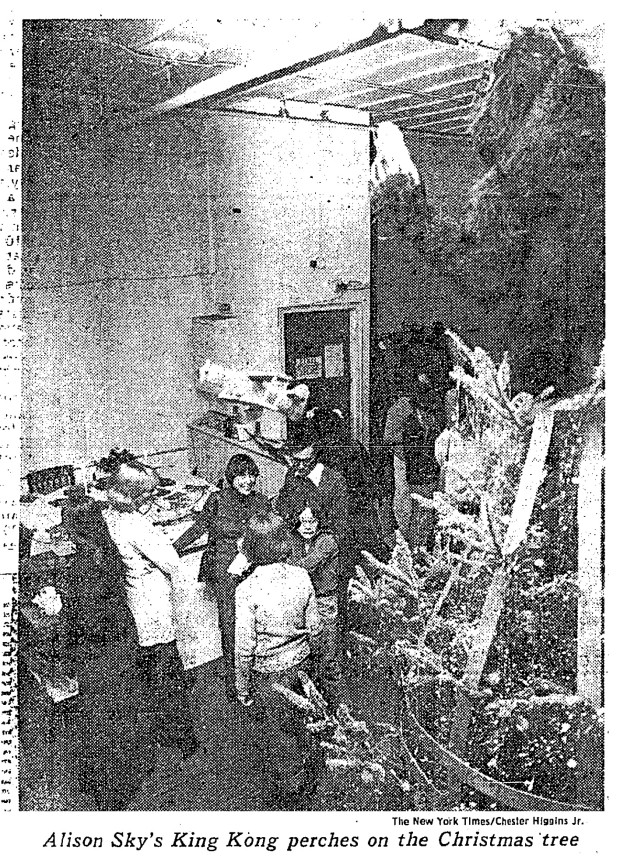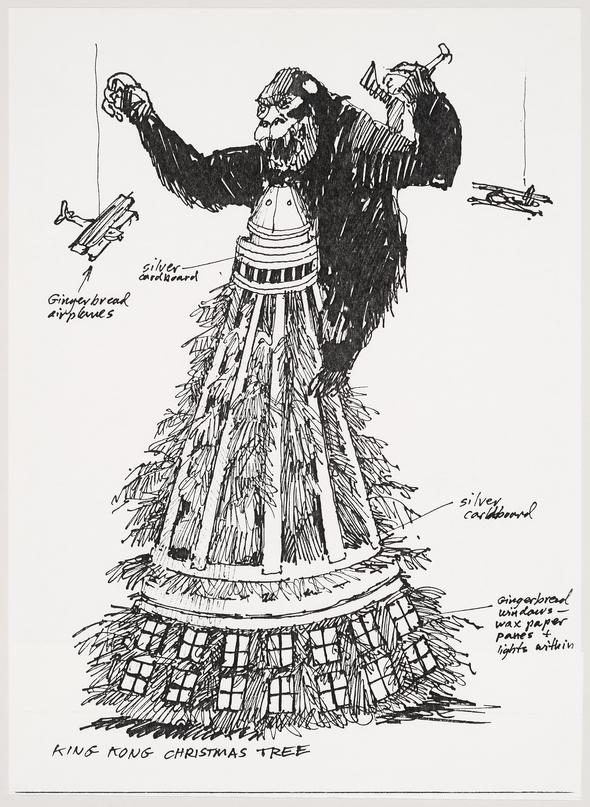An iconographic and text archive related to communication, technology and art.
☛ Canadian Centre for Architecture: James Wines, hand drawing of a King Kong figure atop a Christmas tree. Invitation sent to Gordon Matta-Clark to attend SITE’s Christmas party, 60 Greene Street, New York City, December 28, 1976. 35.4 x 21.6 cm. CCA Collection. PHCON2002:0016:004:085. Gift of Estate of Gordon Matta-Clark © SITE.
There are many more interesting items to discover online at the Canadian Centre for Architecture Collection. The Collection has its own RSS feed and the CCA maintains an active presence on Facebook, Twitter, Tumblr and YouTube.
• • •
The Canadian Centre for Architecture provides the following explanation regarding the context in which this drawing was produced:
Inspired by the adaptation of King Kong by Dino Delaurentis, this 1976 Christmas party invitation was designed by James Wines, president of SITE. The King Kong theme ran throughout the party. “Gorilla cookies and fay wray punch will be served,” the invitation reads. SITE co-founders Alison Sky, Michelle Stone and Wines’ daughter Suzan designed a Christmas tree modelled on the Empire State Building and adorned with a King King doll made by Sky. The SITE holiday event that year was a great success and even had coverage in the NY Times, with guests including Andy Warhol, Bob Smithson, Nancy Holt, and Gordon Matta-Clark, among many others from the New York art world. (CCA Collection: “A King Kong Christmas”, December 20, 2013)
The New Times article to which the CCA’s description referred was written by Rita Reif and it was published on December 30, 1976: “In SoHo, King Kong Cookies And Fay Wray Punch…” (there’s a fee to access the full article). The report written by Reif provides a detailed description of the party. It also tells the story of just how the actual King Kong Christmas tree was put together:
They came to the party to see a gorilla grab at airplanes from his perch atop the 12-foot Christmas tree. Or was it the Empire State Building?
They came to eat gorilla cookies and drink Fay Wray punch.
They came to talk about Kong Kong, his taste in architecture, his taste in women and how gingerbread should taste.
In fact, about 50 guests gathered the other night in a lower Manhattan loft for the fantasy-filled party planned by the designers and writers who make up the five-member staff of Site Inc. (Sculpture in the Environment). And many of the invited lingered ―in the appartment that is 33 blocks south of the Empire State Building and 18 blocks north of the World Trade Center― on onto the next morning munching, sipping and mulling such monstrous questions as “What is King Kong made of?”
“Love, mostly,” Alison Sky answered over and over again, invariably with a broad smile and a nod at what was described as the most strokeable simian in SoHo. “It’s also leather and vinyl and synthetic gorilla fur. And it’s stuffed with steel and polyester.”
When Miss Sky began a year ago to hand-sew that ape with the enigmatic smile, it was a private project, she said, a gift for Suzan Wines, the daughter of the artist-writer’s Site colleague James Wines, a sculptor. Miss Sky had no idea then, she recalled the other night, that it would take two months to complete. She also had not reckoned on the amount of labor and the number of people that the effort would involve. […]

[T]he full work force did not become involved until shortly before Christmas. Miss Sky had pondered out loud the problem of how to decorate this years’s tree. And when she proposed doing a King Kong, her colleagues roared their approval and fell to work. Michael McDonough, an architect-trained associate, drew plans for the silvery cardboard-and-wax-paper-framed skyscraper that would surround the tree, on top of which the stuffed gorilla would pause for the Yuletide season.
“We never considered the World Trade Center,” Mr. Wines reported emphatically, adding that several of the invited had called to say that if the tree were based on the current Dino Di Laurentiis [sic] remake of the 1933 monster classic and framed with the towers, they were not coming.
“Our King Kong is a takeoff on the original and the building had to be the original one that the real King Kong fled to,” he said. (The New York Times: “In SoHo, King Kong Cookies And Fay Wray Punch…” by Rita Reif, Dec. 30, 1976).

I asked @ccawire for additional information about SITE’s King Kong Christmas tree and they kindly pointed me to the book SITE: Identity in Density (Master Architect Series VI) (Images Publishing, 2005; Amazon). In it Michael McDonough, who had drew the original plans for the tree, gives his personal account of the King Kong Christmas party. As it turns out, the party played some role in SITE’s early notoriety:
We were all very young, mostly broke, serious-minded, and determined to change the world. The world, curiously, mostly noticed, I remember when Dino DeLaurentis filmed his campy remake of King Kong in 1976. Most Downtown turned out as unpaid extras in the plaza of the World Trade Center, all of us celluloid witnesses to the great ape’s denouement. SITE celebrated the event with a King Kong Christmas Tree party that year, the centerpiece a cardboard confection of the Empire State building topped by the angel Kong himself. The then still oh-so-dowdy New York Times reported the event, complete with a group portrait. It was like Paris in the 1920s, our Greene Street Mafia, but the style was grunge before there was grunge. (“The Greene Street Mafia: Remembering Site and Soho in the Mid-1970s” by Michael McDonough, in SITE: Identity in Density (Master Architect Series VI), edited by Steve Womersley, Victoria: Images Publishing, 2005, p. 17)
To learn more about SITE philosophy and numerous achievement, visit its official website either at sitenewyork.com or at siteenvirodesign.com. Founder James Wines also teaches architecture at Penn State University: see his profile there.
- By Philippe Theophanidis
- on
- ― Published in Architecture, Art, Design, Movies
- Tagged: Christmas, King Kong, New York, party

